#Santo Domingo de Guzman
Explore tagged Tumblr posts
Text
Santo Domingo de Guzmán, la última obra de Alejandro López
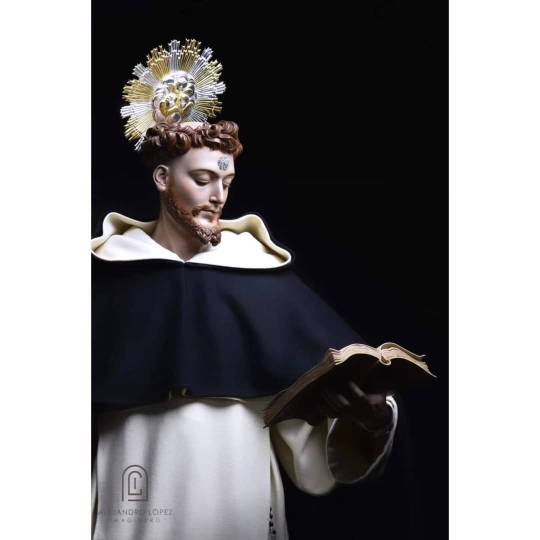
Los Santos son para la Iglesia un modelo de vida que se ofrece al creyente, así como intercesores entre Dios y los hombres. Sus distintos carismas hacen que podamos sentirnos identificados con ellos y que provoquen el despertar o aumento de la vocación que el Espíritu Santo provoca en cada uno de nosotros. Por eso es tan importante que sus representaciones, a través de las imágenes sagradas, transmitan los valores que encarnan y aparezcan imbuidos en una honda espiritualidad.

Todo eso es lo que encuentro en la obra de Alejandro López Imaginero, que podríamos calificar como el imaginero de las órdenes religiosas, puesto que dota a este género de una dignidad, monumentalidad y mundo interior verdaderamente únicos.
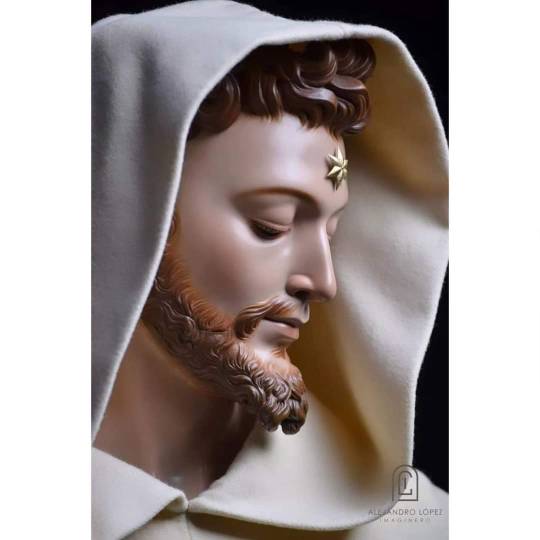
Su última obra es este Santo Domingo de Guzmán para la iglesia de su nombre en Guadix (Granada), que aparece totalmente concentrado en la lectura de un libro mariano. Nos lo representa en su juventud, con un rostro delicado, cuya quietud contrasta tanto con el dinamismo de los cabellos rizados, como con la propia postura, de enorme elegancia y gallardía, que nos deja ver al caballero cristiano, cuyas armas son la oración, el conocimiento y la fe, que le hacen merecedor del lábaro de la victoria ante el maligno. No podemos dejar de lado la riqueza en matices de la encarnadura, así como la cuidada vestimenta y su disposición, ideada por el propio autor.
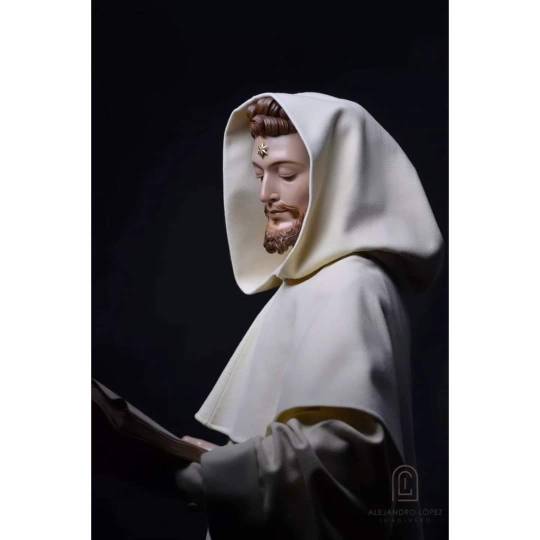
Quizás Alejandro López sea el imaginero que mejor ha sabido adaptar al siglo XXI la estética granadina, de la que bebe en muchas de sus obras, llevándola a las más altas cotas de calidad.
Jesús Romanov Alfonso
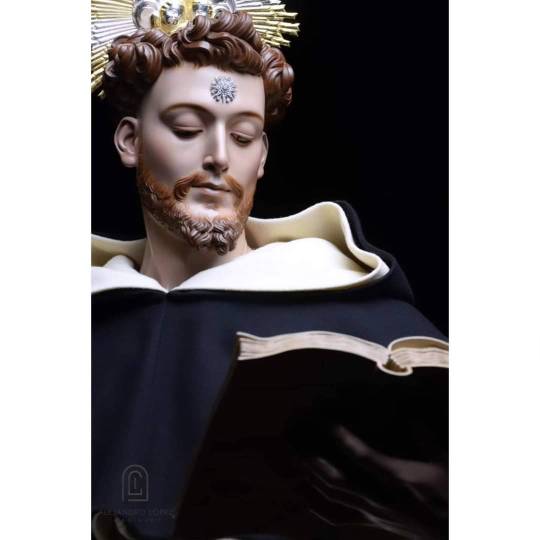
1 note
·
View note
Text
Pre Italian
share.libbyapp.com/title/3369121
View On WordPress
#Base#bookporn#Camilleri Andrea#Cosmic Thing#el Varon de La Atalaya#English as a Second Language#ESL#giallo#Guzman#iGuzmani#la raza#la source#Libby#Los Guzmanes#Los Misterios#Noir#Pan American#practice English#Q#Quelle#Santo Domingo de Guzman#spain#Sto Dgo de Guzman#translation#trinacria#viva L’Italia
0 notes
Text
DO YOU KNOW WHY YOU SHOULD PLACE THE ROSARY UNDER THE PILLOW? !!!
It is recommended to keep a rosary, even if it is small, under the pillow.
Since I took this habit, my problems are solved more easily and it is a good method for those who have insomnia, you will see that they wake up with the rosary in their hands and have had a good rest.
Meaningful actions gain more power when their origin is known.
A beautiful story....
You also didn't know the story of the rosary?
I always wondered:
Who's had it happen to repeat the Marybirds so many times? What does that make any sense? , etc.
Now it is understood and every time they pray it, every Hail Mary is a beautiful rose for the Virgin. It is sure that we all know this beautiful prayer that is the Holy Rosary.
A legend has it that a Lego Brother (who was not a priest) of the Order of the Dominicans, could not read or write, so he could not read the Psalms, as was the custom in the convent of the time.
So, when he finished his chores at night (he was the goalkeeper, sweeper, mint, etc.) ) he went to the chapel of the convent and stood in front of the image of the Virgin Mary, and recited 150 Avemarias (the number of psalms), then retreated to his cell to sleep. In the morning, early in the morning, he would get up before all his brothers and head to the chapel to repeat his custom of greeting the Virgin.
The Senior Brother noticed that every day, when he came to the chapel to celebrate the morning prayers with all the monks, there was an exquisite smell of freshly cut roses and it made him curious, so he asked everyone who was in charge of adorning the altar of the Virgin so beautifully, to what the answer was that no one did, and the roses of the garden were not missing from their flowers.
Brother Lego became seriously ill; the other monks noticed that the Virgin's altar did not have the usual roses, and deducted that he was the one who put the roses. But how?
No one had ever seen him leave the convent, nor did they know he bought the beautiful roses.
One morning they missed that he had risen, but they couldn't find him anywhere. At last, they met in the chapel, and every monk entering was amazed, for brother Lego was kneeling in front of the image of the Virgin, ecstasy reciting his Avemaries, and to each one leading the Lady, a rose appeared in the vases. So after finishing his 150 salutations, he fell dead at the feet of the Virgin.
Over the years, Santo Domingo de Guzman, (it is said to be for the revelation of the Blessed. Virgin ) divided the 150 avemaries into three groups of 50, and associated them with Bible meditation: The Joyful Mysteries, the Sorrowful Mysteries and the Glorious Mysteries, to which Saint Pope John Paul II added the Luminous Mysteries.
CHARGE YOUR ROSARY EVERY DAY
When you carry your Rosary, it's a headache to the enemy
When you use your Rosary, Satan collapses
When he sees you praying the Rosary, he fades away.
Let us Pray the Rosary every time, to keep the Enemy vanished.
Perhaps when you try to re-send this message, something is going to try to discourage you, but forward it anyway and you will see later how the Holy Spirit works, also in this way, collaborating to accelerate the triumph of the Virgin Mary.
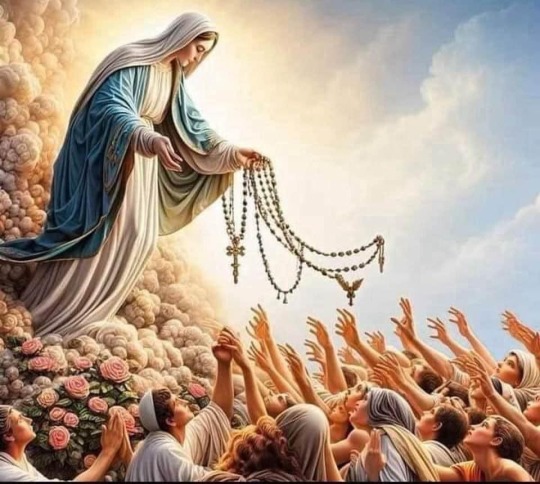
3 notes
·
View notes
Text
This is the Christmas Station ID of TV5 in 2010. The Christmas Station ID was themed “Maligayang Pasko, Kapatid! In the Service of the Filipino”. The Station ID is accompanied with the Christmas version of “Para Sa’yo Kapatid” performed by Jose Mari Chan and Apo Hikng Society featuring Regine Velasquez. But somehow, Ogie Alcasid and Regine Velasquez also performed the original version of the “Para Sa’yo Kapatid” in June 30, 2010.
The Christmas Station ID was launched in December 1, 2010 which is the same thing that the “Da Best ang Pasko ng Pilipino” music video was released from ABS-CBN.
The Christmas Station ID features Luchi Cruz-Valdez, Pinky Webb, Korina Sanchez, Pia Arcangel, Connie Sison, Ivan Mayrina, Mark Salazar, Raffy Tima, Lourd de Veyra, Shawn Yao, Paolo Bediones, Martin Andanar, Seph Ubalde, Atom Araullo, Rhea Santos, Alex Santos, Zen Hernandez, Pinky Webb, Mai Rodriguez, Chiqui Roa-Puno, Alex Santos, Mario Dumaual, Gilbert Remulla, Emil Sumangil, John Consulta, Grace Lee, Sam Milby, Bea Alonzo, Marco Alcaraz, Hero Angeles, Vice Ganda, Empoy Marquez, Coco Martin, Zoren Legaspi, Ogie Alcasid, Luis Manzano, Matteo Guidicelli, DingDong Dantes, Enchong Dee, Rocco Nacino, Dennis Trillo, IC Mendoza, Jerald Napoles, Carmina Villaroel, Eugene Domingo, Nora Aunor, Angel Aquino, Aiko Melendez, BB Gandanghari, Randy Santiago, John Wayne Sace, Allen Dizon, John Arcilla, Gabby Eigenmann, Geoff Eigenmann, Edu Manzano, Jericho Rosales, Neil Coleta, Cogie Domingo, Lloyd Zaragoza, Kit Thompson, Nash Aguas, Valeen Montenegro, Emman Abelda, Joshua Dionisio, Enrique Gil, Carlo Aquino, Liza Soberano, Michael V., Allan K., Xian Lim, Yves Flores, German Moreno, Carmelito “Shalala” Reyes, Romy “Dagul” Pastrana, Aga Muhlach, Sid Lucero, Onemig Bondoc, Diether Ocampo, Ruru Madrid, Juancho Triviño, Ina Raymundo, Dina Bonnevie, Ahron Villena, Jun Sabayton, Niño Muhlach, Simon Ibarra, Baron Geisler, Dominic Roque, Ramon Bautista, Gian Magdangal, Chuckie Dreyfus, Mark Anthony Fernandez, Tirso Cruz III, Diego Castro III, Rafael Rosell, Jake Cuenca, Troy Montero, Antonio Aquitania, Isko Moreno, Lester Llansang, John Lapus, Arcee Muñoz, Alice Dixson, Tuesday Vargas, Ritz Azul, Eula Caballero, Kristine Hermosa, Angel Locsin, Coleen Garcia, Shaina Magdayao, Ellen Adarna, Louise de los Reyes, Jessie Mendiola, Ivana Alawi, Maja Salvador, Ivan Dorschner, Enrico Cuenca, John Lloyd Cruz, Benjamin Alves, Paulo Avelino, EJ Falcon, David Licauco, Ken Chan, CJ Muere, Pancho Magno, Paolo Serrano, Renz Fernandez, Adrian Alandy, Derrick Monasterio, Lance Serrano, Marky Cielo, Vince Gamad, Jiro Manio, Addy Raj, Dianne Medina, RR Enriquez, Princess Ryan, Sunshine Cruz, Kim Chiu, Pauleen Luna, Heaven Peralejo, Sanya Lopez, Lianne Valentin, Enzo Pineda, Marco Gumabao, Dion Ignacio, Jason Abalos, Regine Velasquez, JC de Vera, Martin Escudero, Gerald Anderson, Sef Cadayona and Edgar Allan Guzman including Julius Babao and his wife Christine Bersola-Babao, Mikoy Morales, the son of Vicky Morales, Ronwaldo and Kristoffer Martin, the sons of Coco Martin and Sandino Martin, the brother of Coco Martin, twin brothers Rodjun and Rayver Cruz, Master Boy Abunda, DJ Willie Revillame, Emcee Mo Twister, The Smosh Cast Members Anthony Padilla, Ian Hecox, Caleb Logan Bratayley, DJ Lance the Dinosaur from Sesame Street, Blue the Puppy from Disney’s Blues Clues who is the mascot of TV5, South Korean Boy Band Momoland and president Noynoy Aquino as Santa Claus featuring the Goin Bulilit new cast members like CX Navarro, Mutya Orquia, Donny Pangilinan, Belle Mariano, Charlie Dizon and more after the retirement of the original cast members like Vin Abrenica, Sophie Albert, Mark Neumann, Shaira Mae Diaz, Akihiro Blanco and Chanel Morales who appeared as special guests. But somehow, Vin Abrenica, Sophie Albert, Mark Neumann, Shaira Mae Diaz, Akihiro Blanco and Chanel Morales moved to ABS-CBN where they became the Artista Academy students.
Somehow, This was also the only Christmas Station ID to feature Marky Cielo before his death in November 30, 2012 due to a cardiac arrest. Somehow, Mel Tiangco, Howie Severino, Dominic Roco, Felix Roco, James Reid, Nadine Lustre and twin sisters Anne Curtis and Jasmine Curtis-Smith don’t appear in the Christmas Station ID at this point due to their retirement from TV5. Also Ram Revilla did not appear because he died in December 30, 2009.
The Christmas Station ID theme will be re-used in the 2011 Christmas Station ID from TV5 which is “Magpasaya ang Kapatid” but with minor changes and fireworks at the very end. Somehow, The fireworks at the very end will occur in the 2015 Christmas Station ID which is “Happy Ka Dito Ngayon Pasko” which will feature special guests like Rufa Mae Quinto, Julia Montes, Cristine Reyes, Dimples Romana, Alex Gonzaga, Roxanne Guinoo, Angelica Panganiban and Valerie Concepcion waving at the end.
#tv5#maligayang pasko#merry christmas#happy holidays#parasaiyokapatid#in the service of the filipino#christmas station id#magpasaya ang kapatid
2 notes
·
View notes
Text
Today, the Church remembers Saint Dominic (Spanish: Santo Domingo), (8 August 1170 – 6 August 1221 A.D.), a Castilian priest and founder of the Dominican Order.
Ora pro nobis.
In the earliest narrative source, by Jordan of Saxony, Dominic's parents are named Felix Guzman and Juanna of Aza. The story is told that before his birth his barren mother made a pilgrimage to the Abbey at Silos, and dreamt that a dog leapt from her womb carrying a flaming torch in its mouth, and "seemed to set the earth on fire." This story drew resonance from the fact that his order became known, after his name, as the Dominican order, Dominicanus in Latin which a play on words interpreted as Domini canis: "Dog of the Lord." Jordan adds that Dominic was brought up by his parents and a maternal uncle who was an archbishop.
The failure to name his parents is not unusual, since Jordan wrote a history of the Order's early years, rather than a biography of Dominic. A later source, still of the 13th century, also gives their names as Juana and Felix. Nearly a century after Dominic's birth, a local author asserted that Dominic's father was "vir venerabilis et dives in populo suo" ("an honoured and wealthy man in his village"). The travel narrative of Pero Tafur, written circa 1439 (about a pilgrimage to Dominic's tomb in Italy), states that Dominic's father belonged to the family de Guzmán, and that his mother belonged to the Aça or Aza family.
Dominic was educated in the schools of Palencia (they became a university soon afterwards) where he devoted six years to the arts and four to theology. In 1191, when Spain was desolated by famine, young Dominic gave away his money and sold his clothes, furniture and even precious manuscripts to feed the hungry. Dominic reportedly told his astonished fellow students, "Would you have me study off these dead skins, when men are dying of hunger?" In 1194, around age twenty-five, Dominic joined the Canons Regular in the canonry in the Cathedral of Osma, following the rule of Saint Augustine.
Around 1205, Dominic, along with Diego de Acebo, began a program in the south of France, to convert the Cathars, a Christian religious sect with gnostic and dualistic beliefs, which the Roman Catholic Church deemed heretical. As part of this, Catholic-Cathar public debates were held at Verfeil, Servian, Pamiers, Montréal and elsewhere. Dominic concluded that only preachers who displayed real sanctity, humility and asceticism could win over convinced Cathar believers. However, even Dominic managed only a few converts among the Cathars.
In 1215, Dominic established himself, with six followers, in a house given by Peter Seila, a rich resident of Toulouse. Dominic saw the need for a new type of organization to address the spiritual needs of the growing cities of the era, one that would combine dedication and systematic education, with more organizational flexibility than either monastic orders or the secular clergy. He subjected himself and his companions to the monastic rules of prayer and penance; and meanwhile Bishop Foulques gave them written authority to preach throughout the territory of Toulouse.
In the same year, the year of the Fourth Lateran Council, Dominic and Foulques went to Rome to secure the approval of the Pope, Innocent III. Dominic returned to Rome a year later, and was finally granted written authority in December 1216 and January 1217 by the new pope, Honorius III for an order to be named "The Order of Preachers" ("Ordo Praedicatorum", or "O.P.," popularly known as the Dominican Order).
Blessed Cecilia Caesarini, who was received by Dominic into his new order, in her old age described him as "...thin and of middle height. His face was handsome and somewhat fair. He had reddish hair and beard and beautiful eyes ... His hands were long and fine and his voice pleasingly resonant. He never got bald, though he wore the full tonsure, which was mingled with a few grey hairs."
Although he traveled extensively to maintain contact with his growing brotherhood of friars, Dominic made his headquarters in Rome. In 1219, Pope Honorius III invited Dominic and his companions to take up residence at the ancient Roman basilica of Santa Sabina, which they did by early 1220. Before that time the friars had only a temporary residence in Rome at the convent of San Sisto Vecchio, which Honorius III had given to Dominic circa 1218, intending it to become a convent for a reformation of nuns at Rome under Dominic's guidance. The official foundation of the Dominican convent at Santa Sabina with its studium conventuale, the first Dominican studium in Rome, occurred with the legal transfer of property from Pope Honorius III to the Order of Preachers on 5 June 1222, though the brethren had taken up residence there already in 1220. The studium at Santa Sabina was the forerunner of the studium generale at Santa Maria sopra Minerva. The latter would be transformed in the 16th century into the College of Saint Thomas and then in the 20th century into the Pontifical University of Saint Thomas Aquinas, Angelicum sited at the convent of Saints Dominic and Sixtus.
In the winter of 1216–1217, at the house of Ugolino de' Conti, he first met William of Montferrat, Dominican friar, afterwards a close friend. According to Guiraud, Dominic abstained from meat, "observed stated fasts and periods of silence", "selected the worst accommodations and the meanest clothes", and "never allowed himself the luxury of a bed". "When travelling, he beguiled the journey with spiritual instruction and prayers". Guiraud also states that Dominic frequently traveled barefoot and that "rain and other discomforts elicited from his lips nothing but praises to God".
Dominic arrived in Bologna on 21 December 1218. A convent was established at the Mascarella church by the Blessed Reginald of Orleans. Soon afterwards they had to move to the church of San Nicolò of the Vineyards. Dominic settled in this church and held here the first two General Chapters of the order.
Dominic died at the age of fifty-one, according to Guiraud "exhausted with the austerities and labours of his career". He had reached the convent of St Nicholas at Bologna, Italy, "weary and sick with a fever". Guiraud states that Dominic "made the monks lay him on some sacking stretched upon the ground" and that "the brief time that remained to him was spent in exhorting his followers to have charity, to guard their humility, and to make their treasure out of poverty". He died at noon on 6 August 1221. His body was moved to a simple sarcophagus in 1233. Under the authority of Pope Gregory IX, Dominic was canonized in 1234.
O God of the prophets, you opened the eyes of your servant Dominic to perceive a famine of hearing the word of the Lord, and moved him, and those he drew about him, to satisfy that hunger with sound preaching and fervent devotion: Make your Church, dear Lord, in this and every age, attentive to the hungers of the world, and quick to respond in love to those who are perishing; through Jesus Christ our Lord, who lives and reigns with you and the Holy Spirit, one God, forever and ever.
Amen.
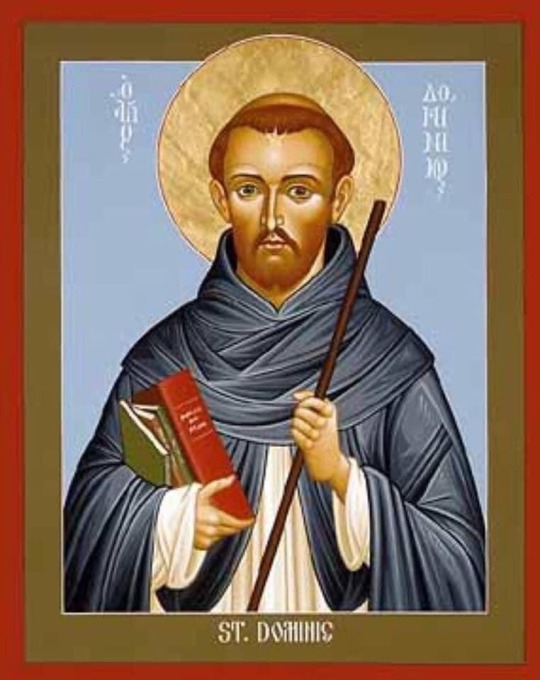
2 notes
·
View notes
Text
Llorarás (Salsa Version) - Aneudys Guzman
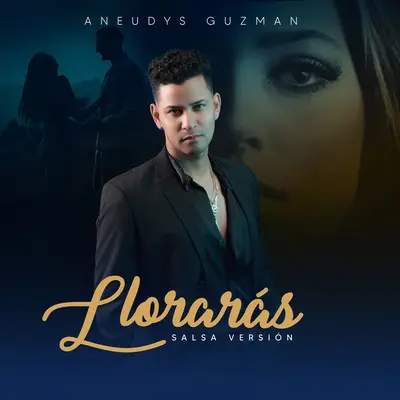
Aneudys Guzmán lanza su nueva versión salsa de “Llorarás” Santo Domingo, República Dominicana – El salsero dominicano Aneudys Guzmán presenta su nuevo sencillo “Llorarás”, una versión salsa del famoso tema de Elvis Martínez. Con la producción y el arreglo a cargo de Wilbert Taveras, la canción destaca por su ritmo bailable y enérgico, pensado para el público salsero y bailador. Este tema ya está disponible en todas las plataformas digitales, ofreciendo una propuesta fresca y moderna que rinde homenaje al clásico mientras lo lleva a nuevas alturas. Aneudys Guzmán sigue consolidando su carrera con esta nueva versión, que promete ser un éxito en las pistas de baile. Read the full article
0 notes
Text
BIGRAM SEO BOARD OF DIRECTOR WEBMASTERS EXPERTO SEO" DE NEGOCIOS VIRTUALES, WORDPRESS & WIX , WEBSITE DESIGNERS, WEB DEVELOPERS, GOOGLE MARKETING DIGITAL AGENCY DE PUBLICIDAD PAGINA SITIO WEB DESARROLLADOR, SEO-SEM ( SEO EXPERT ) LOCATED, IN, GRAN SANTO DOMINGO, DE GUZMAN, DN, TOP SEO, BEST SEO EXPERTO DE REPÚBLICA DOMINICANA. DO. EN. ES.
https://laromanaseoexpert.wordpress.com
View On WordPress
0 notes
Text
Criminal Surnames
Ramirez - Murder
Estabillo
Castillo
Lanuza
Reyes - Estafa
Unite - Malpractice
Bernardo - Malpractice
Pasia Torres - Malpractice, Battery, Theft, Slander
Cortes - Malpractice
Francisco - Malpractice
Hilario - Slander
Torres - Slander
Miranda -
GMA 7 / ABS-CBN / TV 5- Slander
Multitel Globe
PLDT
Meralco
Bagtas - Slander
Esperancilla
Cruz
Fernando - Death Threat, Slander, Malignment
Fernandez
Figueroa
Diosemito Gonzales - Death Threat
Tan - DTI
Sy - DTI
Abe Sobrepena - Estafa
Diosemito
Alvarez
Arceo Pascual
Aenel
Acuna
Leano Leanes Leones Leoncio
Mariano
Alvarado
Panganiban Canlas
Valencia Torres - Malignment, Slander
V. Munoz - Estafa, Child Abuse
Domingo
Martin
Bolo
Mendoza
Isidoro
Faundo
Veloso
Cortes
Reyes - Estafa
Santos - Estafa
De Leon
Pacheco
Caparas Celis
Famorca
Figueroa
Ocampo
Garcia
Galema
Senensa Paguio Bulan
Estrella Pancho Concpcion
Bacani Lopez Alonday Dela Cruz Nadolza Alday Pena Vicente Manansala Manansala Manalaysay Manalastas
Lopez Melba Bernal Lorenzo Pena Vicente
Pajaro Morales Villanueva Trinidad Marcos Aquino Del Rosario
Tanghal Isogawa Shimoda
Yco Pichay Mateo Teodoro Diolata Timoteo Benemerito Barro Bernabe Batongbacal
A. Mia
Espiritu Carandang
Batanes Escalante Esquilona
Arambulo Bugay - Child Abuse
Eusebio
Calalang
Sarmienta Caladiao
Wong - Slander
Catacutan
Cuevas
Valenzuela Javier
De Guzman - Malignment, Slander
San Migeuel Beer
Jimenez
Buhain Abuel - Malignment, Slander
Yabut Yakit
Valdes Serrano
Kobayashi
Sebastian
Dinong
Soco
Arceo Pascual
Etrata
Lopez Santiago Amarillo Barro Estinos Carandang Torres - Malignment, Slander
Sierra Bernardo - Prostitution, Human Trafficking
Cristobal
Robles
Magno - Frustrated Murder
De Luna - Frustrated Murder
Baniqued - Death Threat
Hernandez Mallari - Death Threat, CJ 2023 Marcos Admin
Bravo
Cayetano
Herrera
Del Rosario - Slander, Child Abuse, Estafa
Villanueva - Slander, Child Abuse, Estafa
SM ROBINSONS - Slander
Ayala - ?
0 notes
Text
Explorando la Trayectoria de Chamel Gaspard: Un Empresario Venezolano con Raíces y Compromisos Profundos
Nacido el 15 de febrero de 1959 en Caracas, Venezuela, Chamel Gaspard personifica una historia de dedicación, valores familiares y contribuciones significativas. Hijo de Antonio Gaspard y Dolores Francisca Morell, Chamel proviene de una rica herencia que fusiona las tradiciones libanesas y catalanas.
La llegada de su padre, Antonio Gaspard, a Venezuela en enero de 1948, marcó el inicio de una búsqueda por un futuro basado en trabajo honesto y constante. Originario de una familia tradicional del norte de Líbano, Antonio se unió a miles de inmigrantes que anhelaban oportunidades en suelo venezolano. Por otro lado, Dolores Francisca Morell, su madre, aportó a la mezcla sus raíces como hija de comerciantes catalanes.
Chamel Gaspard, el tercer hijo de la familia, comenzó su educación en el Colegio La Salle la Colina, donde recibió una formación integral, tanto religiosa como deportiva, valores que ha mantenido y cultivado a lo largo de su vida. Su paso por el Colegio Domingo Savio de los Teques le dejó una profunda devoción por la Virgen María Auxiliadora, que ha guiado sus decisiones en lo personal, familiar y profesional.
Durante sus años formativos, Chamel Gaspard no solo fortaleció su fe religiosa, sino que también adquirió disciplina en los estudios, orden personal, buen comportamiento, formación deportiva y desarrollo personal. Estos principios, inculcados desde su nacimiento por sus padres, enfatizaban la importancia del trabajo, la honestidad, el bienestar del prójimo y ser generadores de empleo.
Después de completar su bachillerato en Ciencias en el Colegio Emil Friedman en Caracas, Chamel Gaspard se aventuró a Inglaterra, donde se sumergió en estudios de Ingeniería Mecánica en el Lincoln Collage of Technology y Sunderland Polytechnic, graduándose con Honores en Segundo Grado en 1981. Este periodo estuvo marcado por el sacrificio académico debido a la rigurosa educación inglesa, que exigía responsabilidad continua y pruebas universitarias al final de cada año académico.
A los 18 años, mientras estudiaba en Lincolnshire, Chamel Gaspard demostró su valentía al salvar a una mujer ahogada en el río While, ganándose el reconocimiento de la Reina Isabel por su coraje. Siguiendo el ejemplo de su padre, siempre conjugó sus estudios con oportunidades de trabajo para costear su educación en el extranjero.
Como filántropo comprometido, Chamel Gaspard ha extendido su mano solidaria a los más necesitados, brindando becas a estudiantes de escasos recursos y apoyando a la comunidad estudiantil. Junto con su hermano José, ha facilitado el acceso a viviendas para colaboradores del Grupo J Gaspard, demostrando su compromiso con el bienestar de su equipo y las comunidades circundantes.
Chamel Gaspard, a lo largo de los años, ha extendido su generosidad a diversas comunidades, apoyando escuelas, hospitales, comedores infantiles e iglesias. Uno de los ejemplos notables es su colaboración con la Iglesia Santo Domingo de Guzman en Lechería, trabajando junto al Monseñor Enrique Ovies González para impulsar iniciativas beneficiosas para la comunidad.
En este blog, exploraremos más a fondo la vida y las contribuciones de Chamel Gaspard, destacando cómo sus valores, experiencias y acciones han dejado una huella positiva tanto en el ámbito empresarial como en el bienestar de las comunidades a las que ha servido.
#chamel gaspard morell#jose gaspard panama#chamel gaspard#jose gaspard morell#hermanos gaspard#jose gaspard y chamel gaspard#jose y chamel gasaprd#jose gaspard#hermanos gaspard panama
0 notes
Text
Oaxaca Museums
We stopped to visit a couple of the local museums.
The Cultural Museum in the Old Convent section of Santo Domingo de Guzman is large and spectacular. On our way there we walked through the Church, the largest and most spectacular Dominican Churches in the Oaxaca area.
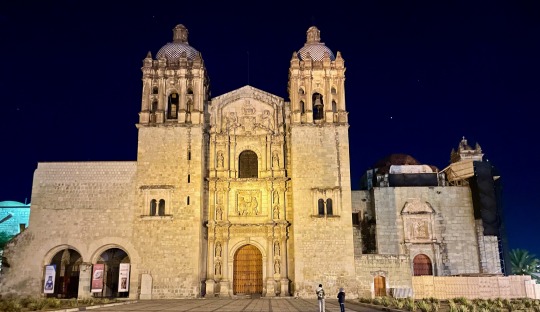
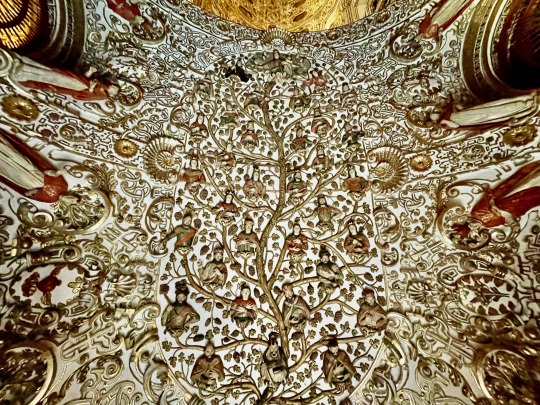
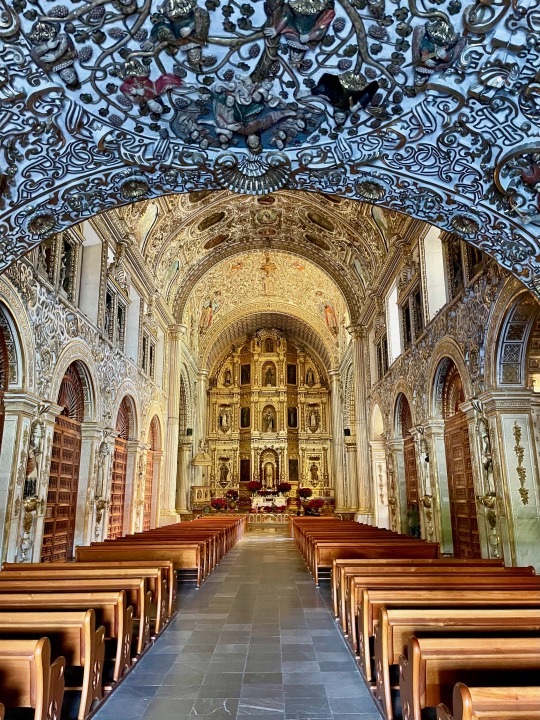

The convent was also the largest and they have restored it beautifully after the government had used it as a barracks and such.
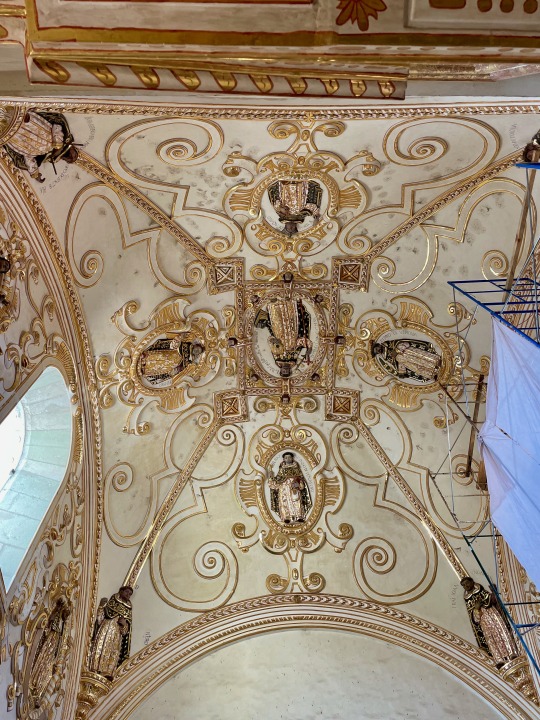
The new exhibit there was of the artifacts they found in a tomb in the nearby ruins of Monte Alban.
There were hundreds of gold and carved bone objects in the tomb. I'm always amazed at the craftsmanship of the precolumbian societies.

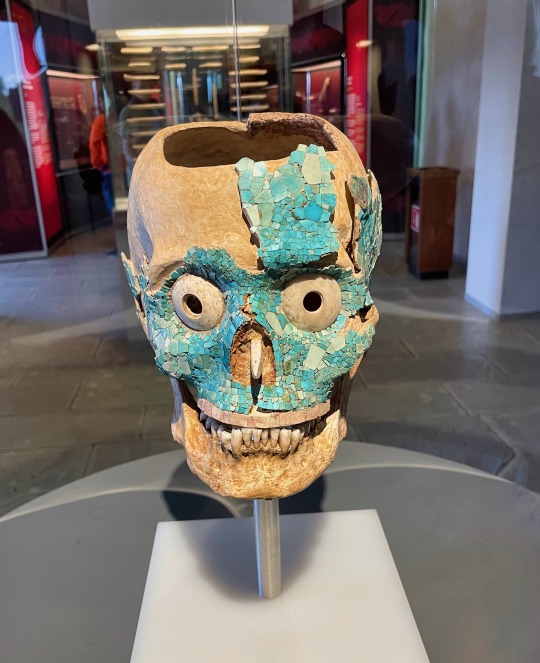
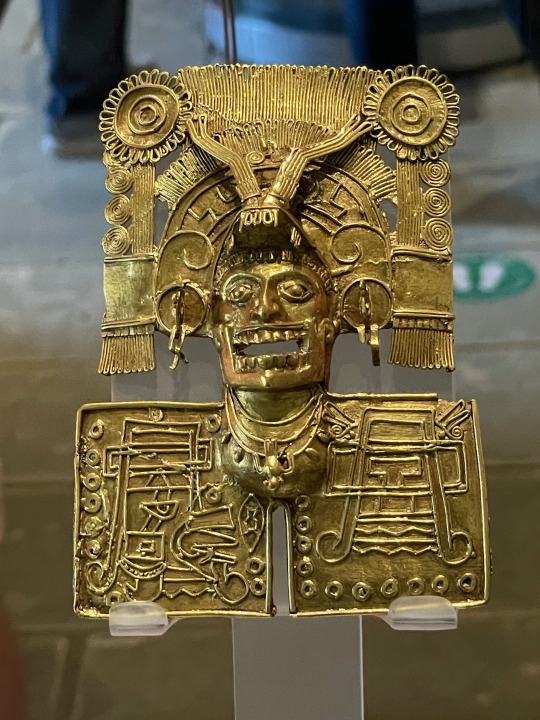


The carved bones were incredible. These are the leg bones of some fairly small animal, certainly no larger than a deer. Click on the images to zoom in for detail.


Oaxaca also has a Museum of Oaxacan Painters showing contemporary local painters, in a wide variety of styles. It's free and not huge, but always interesting.




But museums are not the only place to see contemporary artists. There is a vibrant mural culture on the walls of local buildings, inside and out. These are from a small local bar.



As always we find the art and crafts here fascinating, and it's all to o easy to come home with too many new pieces for the collection; more than we really have room for. But we are doing our part to keep the traditions alive.
0 notes
Text
17. Mittwoch 27.12. bis Samstag 30.12.2023

Das Wetter ist heute bewölkt und etwas kühler. Wir gehen zu Fuß in den ca. zwei Kilometer entfernten Ort Santa María del Tule. Hier steht ein 1400 bis 1600 Jahre alter Baum, eine Mexikanische Sumpfzypresse. Mit einem Durchmesser von 14 und einem Umfang von 42 Metern ist er der dickste Baum der Erde und eines der größten Lebewesen der Welt. Der Legende nach wurde er vom aztekischen Gott Ehecatl gepflanzt. Um etwa zwei Meter hinter die erste Umzäunung zu kommen, muss Eintritt bezahlt werden. Bessere Bilder des riesigen Baums schießt man aber eher außerhalb des Zauns.
Im Örtchen Tule herrscht lebhafter Tourismus, es gibt eine große Anzahl von Lokalen, eine Halle mit Essensverkaufständen und kleinere Straßenküchen. Mit dem Einkaufen frischer Lebensmittel sieht es weniger erfreulich aus. Nach langem Suchen entdecken wir ein Sträßchen, in dem es ein paar kleine Läden mit Grünzeug gibt. Wir kaufen viermal ein, bis wir etwas Obst und Brot zusammen haben.
Auf dem Heimweg fängt es an zu nieseln, aber der große Regen setzt erst ein, als wir bei Balou angekommen sind.
Am Donnerstag ist die kurze Regenepisode schon wieder vorbei. Wir nutzen das schöne Wetter für allerlei Aktivitäten am und im Auto und zum Faulenzen.
Am Freitagvormittag gehen wir zu Fuß bis zur Hauptstraße, um einen Bus nach Oaxaca zu erwischen. Ein Taxifahrer bietet sich an, uns für 150 Pesos bis zum Zocaló, dem Platz im Zentrum zu bringen.
Für 11 Uhr haben wir eine englischsprachige Führung gebucht. Die Teilnehmer kommen aus Tschechien, Polen, Dänemark, Kanada, Peru, auch Leute aus Melbourne und New York sind dabei. Die Stadtführerin, Abril, bietet im Hochgeschwindigkeitssprech viel Insiderwissen über die Stadt an. Sie leitet uns durch unterschiedliche Straßen und Stadtteile, Innenbesichtigungen von Gebäuden stehen nicht auf ihrem Plan.
In der Kathedrale Nuestra Senora de la Asunción feiert alles Hochzeit, was Rang und Namen hat. Mit Reservierung, Trauung, Hochzeitsfestzug und Feier im Park hinter der Kirche kommen so ca. 500000 Pesos zusammen, was sich anscheinend nur die reiche Bevölkerung spanischer Abstammung leisten kann. Die indigene Bevölkerung heiratet weniger pompös in Santo Domingo de Guzman.
Wir erfahren über die Erschießungen bei einer friedlichen Studentendemonstration am 2. Oktober 1968 kurz vor Eröffnung der Olympischen Spiele in Mexiko City, bei der über 300 Menschen durch das Militär ums Leben kamen, das das Feuer eröffnet hatte. Oder über die 43 Studenten, die 2016 spurlos verschwanden, nachdem sie zu einer Gedenkdemonstration anlässlich dieser Erschießungen fahren wollten. Laut Abril sind beide Ereignisse durch die damaligen Regierungen zu verantworten und wurden weitestgehend totgeschwiegen.
Der Stadt Oaxaca entstammen der einzige indigene Präsident Mexikos, Benito Juárez, einer der größten Reformer des Landes, sowie der Präsident Porfirio Diáz, der durch seinen autoritären Führungsstil wie auch durch den wirtschaftlichen Aufstieg des Landes in Erinnerung blieb.
In Oaxaca haben sich viele indigene Bräuche erhalten, wie z. B. der Totenkult um Allerheiligen. Mit den Bräuchen mischen sich die vielen Festivitäten, die hier das ganze Jahr über stattfinden. Das größte Festival gibt es im Sommer unter einer riesigen, zeltartigen Überdachung auf einem Hügel über der Stadt, zu dem sich jährlich viele Musiker mit Rang und Namen einfinden.
In Oaxaca verdienen laut Abril 75 Prozent der Bevölkerung ihr Geld mit Kunst oder Kunsthandwerk. Graffitis und Wandbemalungen sind in der Stadt strengstens verboten und werden spätestens nach zwei Tagen abgekratzt oder übermalt. Trotzdem sehen wir in fast jeder Straße kunstvoll bemalte Gebäude.
In Oaxaca wurde auch der Mezcal erfunden. Und ein Platz in einem Viertel wurde speziell dazu erkoren, landestypische Telenovelas oder auch internationale Filme mit mexikanischem Touch zu drehen.
Ziemlich erschlagen von so viel Information setzen wir uns nach der Führung in ein Café, das wir zuvor entdeckt hatten.
Anschließend machen wir uns auf den Heimweg. In der Tourist Info erhalten wir die Auskunft, dass wohl keine Busse Richtung Tule fahren, warum auch immer. Schließlich winken wir ein Taxi mit der typischen rotweißen Bemalung für Überlandtouren heran. Hinten im Taxis sitzen schon drei sehr beleibte Frauen mit viel Gepäck. Aber wir haben vorne zu zweit neben dem Fahrer noch Platz. So eingequetscht fahren wir für 15 Pesos pro Person in die Nähe unseres Autos. Der Transport erinnert uns sehr an eine Fahrt in der Dominikanischen Republik vor einigen Jahren. Da saßen hinten vier Personen und vorne drei, und über jede Sitzbank wurde noch ein Mitfahrer quer reingelegt. Also insgesamt neun Personen, und das in einem Ford Fiesta. Da ist die Fahrt heute im Vergleich doch komfortabel.
Am Samstag beschließen wir, Silvester doch nicht hier auf dem Camp El Rancho zu verbringen, sondern morgen ein Stück weiter Richtung Süden zu fahren.
0 notes
Text

Yo cada vez que quiero ponerme a investigar cosas relacionadas a la vestimenta, peinados y regalia que usaban en la cultura nawat pre colonizacion pero no hay nada, todo es pura informacion de vestimenta post colonizacion con lo poco que se pudo rescatar como cultura nativa siendo los refajos y algunos peinados y tener que investigar mas a fondo y ver mara emputandose que comparen la cultura nawat con la nahuatl algunos hasta negando que la cultura nawat hubiese existido y erroneamente llamandolos maya pipiles cuando CLARAMENTE si teniamos pueblos maya (pocomames y chorti) pero no por eso los "pipiles" (que btw, es un termino erroneo para referirse a los nawat) eran tambien parte de la cultura maya si no se que se tiene registro que eran una cultura hermana de los mexica y ambas caen en la categorizacion de culturas nahuas y hasta habia similitud en deidades a las que se veneraban (vease como por ejemplo el dia de la cruz y como originalmente era una celebracion en honor a Shipetz Tuteku y por eso el uso del palo de ayiote que simula la piel del dios desollado ademas de bañarla para que haya buenas cosechas) pero aun asi hay gente que jode y jode que no y entonces estoy en un vacio donde no se para donde irme si quisiera diseñar un personaje basado en la era pre colonizacion si basarme de registros de vestimenta mexica y tener que vivir con eso que no es "enteramente" basado en la cultura nawat PERO ES QUE FALTAN TANTOS REGISTROS DE LA CULTURA Y AHORA ESTOY EMPUTADO DE NUEVO PORQUE LO UNICO QUE NOS QUEDA SON LAS PERSONAS NAHUAHABLANTES DE SANTO DOMINGO DE GUZMAN, IZALCO, Y OTROS PUEBLITOS PEQUEÑOS.
Que si bien su contribucion a la tradicion oral tanto de la lengua nawat como de creencias y tradiciones que se les fueron transmitidos por sus padres es muy valiosa y apoyo enormemente que se registren los conocimientos que estos nos puedan dar...
...Ya tecnicamente no hay casi nada de como era la cultura nawat pre colonizacion.
#zagreus rambling#no no estoy bien💜💜#saben cuantas horas de investigacion de codices e intentar hayar libros en linea he hecho ademas de buscar entrevistas a nahuahablantes#me he hechado?#mas de las que deberia la neta#“pero de que te preocupas? si igual vos no sos indigena Zag” porque quiero conocer la cultura que existia en mi pais carajo#quiero aprenderla y quiero mostrarsela al mundo con mi arte y quiero que aprendan tambien#desde que estoy chiquito fue algo que me EMOCIONABA#Y ME PINCHES EMPERRA TODO LO QUE PASO
0 notes
Text
SANTO DOMINGO de GUZMAN, Republica Dominicana (La capitaí).

Calle Jose Reyes, Santo Domingo, Republica Dominicana, en el edificio rosado a la Derecho vivía mi tía y donde me hospedaba. Hoy, el Museo de la Porcelana. Al fondo La Iglesia Regina Angelorum.

El día ocho de agosto nació mi hija Paula, el día en que se celebra el patron de la ciudad de Santo Domingo de Guzman. Esta fecha la une con mi país de la Republica Dominicana, ya que ella nació en mi ciudad adoptiva de Valladolid, España y la vincula de alguna manera con mi país natal.

Aunque, para la Iglesia Universal el día de Santo Domingo de Guzmán es el 8 de agosto, PERO para República Dominicana, el Papa Pablo IV instauró en el 1558 que el día de Santo Domingo de Guzmán se celebra el 4 de agosto.

El día de Santo Domingo se celebra el 8 de agosto en honor al santo patrono de la ciudad de Santo Domingo, en la República Dominicana. Es una festividad muy importante para los dominicanos, ya que es una oportunidad para rendir homenaje a su patrón.

La historia de Santo Domingo se remonta al siglo XV, cuando el navegante genovés Cristóbal Colón llegó a la isla y fundó la primera ciudad europea en América, a la que llamó Santo Domingo en honor a su padre, Domingo. Desde entonces, el nombre del santo ha estado estrechamente ligado a la ciudad.
youtube
(681VID1) https://youtu.be/UijlMdNoWlI EL ORIGEN DEL NOMBRE SANTO DOMINGO
El día de Santo Domingo es celebrado con diversas actividades religiosas y culturales. Las iglesias de la ciudad realizan misas especiales en honor al santo, y se lleva a cabo una procesión en la que se recorren las calles principales de Santo Domingo. Durante esta procesión, los fieles llevan imágenes del santo y cantan himnos en su honor. (fuent: ¿Qué día es el día de Santo Domingo? | Felices Vacaciones)
youtube
(681VID2) https://youtu.be/M3fgkK1J3Cs JUAN LUIS GUERRA — LA COSQUILLITA
REF: 681
0 notes
Text
This is the Summer Station ID of ABS-CBN in 2007. The Summer Station ID was themed “Piliin Mo Ang Pilipinas”.
The Summer Station ID theme song was performed by Filipina OPM singer and songwriter Regine Velasquez featuring Filipino singer, songwriter, rapper, dancer, television host, actor and comedian Ogie Alcasid who is Regine Velasquez's husband when they got married in December 30, 2005 which was 1 day before Ogie Alcasid's birthday. Somehow, They had their first child who was born in May 1, 2007. Also starting in June 1, 2007, The theme “Piliin Mo Ang Pilipinas” can be heard on DZMM Radyo 630 and various radio stations nationwide.
The Summer Station ID features Ritz Azul, Alice Dixson, Arcee Muñoz, Tuesday Vargas, Eula Caballero, Roxanne Guinoo, Valerie Concepcion, AiAi delas Alas, Cherry Pie Picache, Carmina Villaroel, Eugene Domingo, Nora Aunor, Lucho Ayala, Gil Cuerva, Rainier Castillo, Raymond Bagatsing, Bayani Agbayani, JC de Vera, Martin Escudero, Gerald Anderson, Sef Cadayona, Edgar Allan Guzman, Cherie Mercado, Kara David, The Tulfo Brothers, Bernadette Sembrano, Mariz Umali, Kim Atienza, Jiggy Manicad, Ted Failon, Arnold Clavio, “Kabayan” Noli de Castro, Marc Logan, Vicky Morales, DingDong Dantes, Marian Rivera, Andi Eigenmann, Dominic Roco, Felix Roco, Bong Revilla, Emman Abelda, Joshua Dionisio, RJ Padilla, Tito Sotto, Vic Sotto, Joey de Leon, Heart Evangelista, Erich Gonzales, Dimples Romana, Robin Padilla, Paolo Ballesteros, Oyo Boy Sotto, McCoy de Leon, Jhong Hilario, Claudine Barretto, Judy Ann Santos, Jodi Sta. Maria, Arjo Atayde, AJ Perez, JM de Guzman, Jeric Gonzales, Jayson Gainza, Zanjoe Marudo, Dianne Medina, RR Enriquez, Sunshine Cruz, Princess Ryan, Kylie Padilla, Bela Padilla, Maine Mendoza, Catherine Bernardo, Edu Manzano, Jericho Rosales, John Lloyd Cruz, Daniel Padilla, Alwyn Uytingco, Julia Montes, Angel Locsin, Coleen Garcia, Shaina Magdayao, Ellen Adarna, Louise de los Reyes, Jessie Mendiola, Ivana Alawi, Maja Salvador, Vhong Navarro, Billy Crawford, Teddy Corpuz, Drew Arellano, Aga Muhlach, Sid Lucero, Onemig Bondoc, Diether Ocampo, John Prats, Joem Bascon, Arra San Agustin, Rufa Mae Quinto, Xian Lim, Luis Manzano, Matteo Guidicelli, Enchong Dee, Benjamin Alves, Rico Barrero, Tom Rodriguez, Hayden Kho, Carl Cervantes, Albie Casiño, Chad Kinis, Kim Chiu, Carla Abellana, Bianca Umali, Sunshine Dizon, Sue Ramirez, Mariel Rodriguez, Krystal Reyes, Toni Gonzaga, Camille Prats, Jennylyn Mercado, Coco Martin, Paolo Serrano, Derek Ramsay, Patrick Garcia, Carlos Agassi, Eric Fructuoso, Long Mejia, Rudy Fernandez, Ryan Agoncillo, including DJ Willie Revillame and Regine Velasquez with her husband Ogie Alcasid after they got married in December 30, 2005.
The Summer Station ID contains the supergroup Bravo All-Stars, the Sexbomb dancers like Shalani Soledad, Iya Villania and Niña Jose and the Goin Bulilit original cast members from TV5 like child actors Angelica Panganiban, Alex Gonzaga, Cristine Reyes, Nash Aguas, Valeen Montenegro, David Licauco, Vince Gamad, Lianne Valentin, Vin Abrenica, Sophie Albert, Mark Neumann, Shaira Mae Diaz, Akihiro Blanco and Chanel Morales. The Summer Station ID also features British boy band One Direction in their pre-debut and Australian born American actor, producer and comedian Will Smith who portrayed Jack Frost in the 2002 movie Frozen as a special guest. Red, Green, Blue and Black Balloons will also be scattered around the world to literally bring forth the summer fun.
The Summer Station ID was filmed in Hollywood, Singapore, Germany, Italy, France, London, Jamaica, Australia, Kenya, Japan, Quezon City, Boracay and New York in June 2006 whenever the ABS-CBN, GMA and TV5 crew members are having a hot summer day into a big summer party.
The Summer Station ID clips will be re-used in the 2013 Summer Station ID of TV5 which is “Bida Best sa Tag-Araw”, The 2014 Summer Station ID of TV5 which is “Pinoy Summer, Da Best 4 Eva!” and the I Gotta Feeling music video from the future movie Ready Player One which will be releasing in March 21, 2013 from Walt Disney Pictures, Walt Disney Animation Studios and Pixar Animation Studios. However, The Summer Station ID reuses the clips of the music videos from those deleted songs Without Me by Dr. Dre and The Real Slim Shady by DMX from the movie Frozen where Will Smith as Jack Frost and Luis Manzano, Xian Lim, Enchong Dee, Matteo Guidicelli and DingDong Dantes as “The Backstreet Boys” were seen including Little Bo Peep from Toy Story and Gelli de Belen as “The Beauty Queen” who also make a cameo at the near end.
But somehow, This is the only Summer Station ID to feature the crew of ABS-CBN, GMA and TV5.
#abs-cbn#summer station id#piliin mo ang pilipinas#in the service of the filipino#choose philippines
2 notes
·
View notes
Text
Paraná: Jesuítas na Provinça do Guairá
C’o Tratado de Tordesi’a, im 1494, as nova terra discuberta a oeste da linha maginária pertencia a Ispanha i a leste a Purtugá. A linha do Tratado de Tordesi’a dividia o Paraná entre as duas potência marítima da época, Purtugá i Ispanha, seno a que úrtima ficô c’a maioria das terra do Istado, deixano só o litorá paranaense sôbre a administração purtuguêsa. Nêsse território que pertencia aos ispanhór num foi um vazio demográfico, apois ali vivia diversos índio da famia lingüística tupi-guarani i jê, se istima que vivia na região im torno de 200 mir índio ispaiado im vários agrupamento, só que suas curtura num tava n'um de munto cunhecimento, apois pissuía u’a agricurtura i cerâmica munto rudimentá, viveno da coleta de cumida pelas mata, da caça i da pesca, os índio inda tava na indade da pedra pulida.¹
Presença ispanhóla
A presença colonizadora ispanhóla no território paranaense cumeçô na segunda metade do século XVI (dezasseis), ispecificadamente im 1554, condo o território formato pelos rio Paraná, Paranapanema, Tibagi i Iguaçú foi incorporado à corôa ispanhóla. O guvernador de Assunção, Martinez de Irala, inviô u’a ispedição de oitenta homes c’a idéia de fundá a vila de Ontiveiros. Só que, im 1524 o viajante ispanhór Aleixo Garcia i im 1542 o conquistador ispanhór Álvar Núñes Cabeza de Vaca já tinha feito ispedição partida do litorá catarinense, discobrino as Catarata do Iguaçú, isprorano tamem o curso do rio Paraguai i submeteu argu’as tribo de índio que mai tarde intrô im confrito cum arguns colono ispanhór chefiado pur Domingo Martínez de Irala.² Os objitivo da intrada do guvernador de Assunção no Guairá é trêis: primêro, a ocupação era cunsiderada istratégica, pensano im istabelecê um porto im Laguna, no litorá de Santa Catarina, a fim de assegurá essa saída p'ro mar i ansim quebrá o isolamento dos colono de Assunção. Sigundo, o povuamento do Guairá permitiria defendê as provinça das cuntínua intrada que fazia os purtuguêis i ao mêmo tempo viabilizá as comunicação cumerciá c’o Brasí, travéis de São Vicente, seno de vantaje tanto p'ros paraguaio como p'ros luso-purtuguêis.³
A cidade de Ontiveiros chegô a tê um grande número de índio, que vivia sob o regime de encomienda, só que a cidade teve u’a curta duração de dois ano, de 1554 a 1556. U’a nova cidade foi construída im 1557, perto da foz do rio Piquiri, adonde hoje se localiza o município de Guaíra i Terra Roxa, pôco riba das istinta Sete Quéda, se chamava Ciudad Real Del Guairá, fundada pur Ruy Dias Malgarejo, adonde foi transferidos os pôco habitante que inda restava de Ontiveiros, que “suverteu” cum isso. Êle mêmo, cum quarenta (40) homes i cinqüenta i trêis (53) cavalo, fundô a sessenta léguas da Ciudad Real u’a tercêra cidade ispanhóla no Paraná, im feverêro de 1570, nas marge do rio Ivaí, a chamada Vila Rica Del Espírito Santo, que recebeu essa nomeação pelo grande despotismo de pedras cum cristá de ágatas que pissuía na região. Im 1592, hôve u’a ipidemia de varíola forçano a transferência de Vila Rica pur orde do capitão Guzman p'ra região perto da foz do rio Corumbataí, no Ivaí. A principar atividade inconômica realizada na região era a istração de erva-mate.⁴
Essas cidade ispanhóla tinha como grande objitivo suborná os índio i garantí a proteção do caminho do Piabiru, que ia de São Vicente, passava na região do Guairá i ia inté o Oceano Pacífico, proximidade de Lima, no Perú, defendeno o acesso a Potosí, cum suas mina de prata, arvo da cobiça purtuguêsa.
Início das redução
C’o tempo, êsse regime de encomienda gerô certa resistênça aos índio, im ispeciá nos índio do tronco jê, como os kaingang, que era mai hostir a duminação ispanhóla. P'ra miór catequizá i invorvê êles no mundo ocidentar, o guvernador Hernando Arias de Saavedra c’a autorização do rei Filipe III, que buscô ampriá os domínio da região, criô a Provinça Del Guairá, tamem cunhecida como “Repúbrica Guarani”⁵ i chamô inté a região os padre jesuíta, dano o comando de istensa faixa de terra. Filipe III foi o rei no chamado domínio ispanhór, entre 1580 i 1640, adonde ocorreu a união entre a coroa purtuguêsa i ispanhóla.Os padre jesuíta criô u’a nova manêra de ministrá a catequese, criano ardeamento, adonde seria mai fácir de protegê os índio i daria u’a maior liberdade aos índio, seno assistido pelos religioso, que passô a estória como o nome de missão jesuítica. A primêra região que isprimentô o sistema de redução jesuítica foi a do Guairá, que passô a atraí um grande número de índio que cumeçô a fugí das encomiendas ispanhóla ino p'ra essa povuação. As primêra redução fundada foi a Nuestra Señora de Loreto i San Ignácio Mini, criadas im 1610. A primêra se situava na foz do rio Pirapó, i passô a sê capitá da provinça, adonde passô a residí o superior da Cumpanhia de Jesus da região. Ao todo, foi fundada quatorze missão principar ispaiada pelos rio Paranapanema, Tibagi, Iguaçú, Piquiri i Ivaí, quar chegô a tê im torno de cem mir (100.000) índio, na maioria guaraní, fazeno prosperá as missão.⁶ O sucesso dessas redução levô a decadência de Ciudad Real i Vila Rica, apois a mão de obra que vivia ali iscoieu ficá nas redução, deixano as encomiendas ispanhóla sem mão-de-obra p'ra istração da erva-mate.
Organização du'a redução jesuítica
As redução era dirigida pur um missionário, que os índio chamava de “pae-véio” im sua língua, i êsse era auxiliado pur um assistente, o “pae-novo.” Os jesuíta procurô não quebrá a hierarquia c’o quar os índio tava curtumado. Tinha propriedades particular i coletiva, que era cuidada i fruitificada im turno pelos índio, que a chamava de “propriedade de Deus”. Tinha u’a criação coletiva de cavalo, boi i galinha. O produto dêsse trabaio era armazenado im depósitos púbrico, adonde cada famia recebia o necessário p'ro seu sustento, seno limitada a distribuição, p'ra que as índia dona de casa num se curtumasse a gastá demasiadamente. Dêsses mêmo depósito tamem se retirava o necessário p'ro curto i o pagamento de imposto, que era pago a coroa ispanhólas. Os missionário não introduziu a o dinhêro entre os índio, p'ra num dispertá cubiça.
O termor dos paulista
C’o sucesso das redução jesuítica, isso gerô temor nos paulista. Entre os principar interesse dos paulista tava o temor du’a ispansão ispanhóla p'ro leste, im direção à baía de Paranaguá, a captura de índio p'ra trabaiá im suas lavôra i o desejo de atingí as famosa mina de Potosí. Os purtuguêis sempre teve a intenção de tê como limite meridionar do Brasí, o rio da Prata, já os ispanhór desejô êsse limite im Cananéia ô inté a baía de Paranaguá.��
C’a ispansão das redução ispanhóla, que já tava açcançano o vale do rio Tibagi, causô u’a pensão entre os paulista, tamem chamados de “mameluco”, que viu como u’a guerra justa, já que ameaçava a inzistênça do Tratado de Tordesi’a. Hai tempos que os paulista organizô bandêras adonde percorria o litorá i o interior campeano índio, que era gerarmente preso i levado a São Paulo, adonde seria vendidos como iscravo.
As ispedição banderante i o fim das redução do Guairá
Os ataque dos banderante paulista se tornô mai freqüente a partí de 1628, principarmente pela omissão do guvernador do Paraguai, Luís de Céspedes Xéria, que nêsse tempo percurava rompê o broco hegemônico do sistema coloniar no Paraguai, entre o Istado i a eigreja, deixano os jesuíta infrentá sozinho os banderante paulista. Os missionário propôs junto ao provinciar do Brasí, Dom Diego de Oliveira a liberdade dos índio, só que não obteve ajuda. Mêmo sem apoio das autoridade paraguaia, i sem apoio das autoridade brasilêra, os jesuíta manteve fiér as orde vinda de Roma.⁷
Os pobrema invorveno os banderante paulista num era novidade no Guairá, como já citado anteriormente, iniciô a tê mai força a partí de 1611, condo o guvernador paulista Luís de Sousa ordenô que os cacique de ardêia próxima a São Paulo fosse buscá índio parente nos sertão do Guairá, p'ra trabaiá nas mina dos purtuguêis.
Os paulista era cunhecido pelos jesuíta i índio como “mameluco,” (o mêmo que “cabôcro”) i a partí de 1628 passô a atacá as missão do Guairá cum verdadêros inzército, principarmente a bandêra liderada pur Antônio Raposo Tavares, organizada im São Paulo no finar de 1628 cum sessenta i nove (69) paulista, novecentos (900) “mameluco” i trêis mir (3 000) índio. Alêm do próprio Raposo Tavares na liderança da bandêra, tamem tava presente o seu irmão Pascual i seu sogro, Manuel Pires.⁸ A primêra missão devastada pelos banderante, inda im 1628, foi a missão de Encarnación, adonde todos os home foi preso i levado como iscravo. As criança, os véio i pessoa mai fraca foi todas morta pelo caminho.⁹

Os banderante paulista era tropas mercenária, que agia pur conta própria, num comprometendo ansim os purtuguêis i nem os ispanhór, os quar num aceitava a inzistênça dessas missão jesuítica. P'ros purtuguêis, devastá o território do Guairá era um modo indireto de desgastá o domínio ispanhór, evitano ansim u’a guerra direta entre as duas coroa. Pur cunseqüência, adespois de distruí a maioria das missão jesuítica no território do Guairá, os paulista oiô p'ra duas cidade ispanhóla na região, Ciudad Real del Guairá i Villa Rica del Espírito Santo, visto que as duas cidade tava praticamente ispósta, cumeçô a pranejá a distruição dêsses núcreo i povuação.¹⁰ O guvernador do Paraguai, im 1630, ispediu u’a orde proibino que os ispanhór de Villa Rica i Ciudad Real num auxiliasse cum armamento de fogo as missão jesuítica.¹¹
Inda fartava duas missão jesuítica não distruída pelos paulista, seno elas Nuestra Señora de Loreto i Santo Ignácio Mini, i adespois da invasão da missão de São Francisco Xavier, os sobrevivênte das povoação próxima a essas missão se tirô inzatamente nas duas primêra missão. O padre Antônio Ruiz de Montoya cunsiguiu juntá 12 000 índio nas duas missão, i cum 700 barsa cunseguiu transportá êsses índio, desceno os rio Paranapanema i Paraná, i se istabeleceu no território da Provinça de Missiones, no noroeste argentino. Dos 12 000 índio levado pur Montoya, cerca de 8 000 cunsiguiu chegá à região argentina, adonde seria reerguida as missão.¹³ Os ispanhór de Ciudad Real del Guairá i Villa Rica sofria pela pobreza derde 1628, teno farta de cumida i de índio p'ra trabaiá na istração de erva-mate. Adespois dos banderante paulista distruí as missão jesuítica, atracô im 1632 as duas cidade, a primêra delas foi Villa Rica, que foi sitiada pur trêis mêis i seus morador fugiu p'ra região mai ocidentar do Paraná i ôtros foi p'ra São Paulo. Os ispanhór de Ciudad Real del Guairá abandonô a cidade temeno os paulista, deixano o Guairá sem nium núcreo de colonização oropéia, c’o fim da colonização pur ação dos paulista, a véia região do Guairá se tornô só u’a região de trânsito p'ra purtuguêis que saía de São Paulo.¹⁴ Mêmo o Guairá pelo Tratado de Tordesi’a seno de posse ispanhóla, os próprio ispanhór foi ispurso de suas terra, i o que antes era chamado de “Repúbrica Guarani” ficô só seno um vazio demográfico, sem nium núcreo populacionar, u’a terra vazia a ispera du’a colonização.
Autoria
Felipe Teixeira Moraes
Tradução
Danfosky
Referênça
CORTESÃO, Jaime. Raposo Tavares e a formação territorial do Brasil, 1966. p. 22
WACHOWICZ, Ruy C. História do Paraná, 2001
GADELHA, Regina Maria. Do Guairá à conquista do Paraná (1553-1680): Subsídios para a história da expansão territorial do Brasil, in Anais do Seminário Internacional, Missionários e Espanhóis: o Paraná no Contexto da Bacia do Prata Séculos XVI e XVII, 2010. p. 22
PARELLADA. Claudia Inês. Vila Rica del Espirito Santo: Ruínas de uma cidade colonial Espanhola no interior do Paraná, 1993. p. 6
LUGON, Clovis. A república comunista cristã dos Guaranis, 1610 a 1768, 1977
PARELLADA. Claudia Inês. Vila Rica del Espirito Santo: Ruínas de uma cidade colonial Espanhola no interior do Paraná, 1993. p. 7
SCHALLENBERGER, Erneldo. O Guairá e o espaço missioneiro: índios e jesuítas no tempo das missões rio platenses, 2006, p. 82
WESTPHALEN, Cecília Maria, BALHANA, Altiva Pilatti. Presença Espanhola no Paraná- Séculos XVI e XVII, 2003, p. 381
LUGON, Clóvis. A república comunista cristã dos guaranis, 1610 a 1768; 1977, p. 46
LUGON, Clóvis. A república comunista cristã dos guaranis, 1610 a 1768. (1977), p. 51
PARELLADA, Claudia. Resistência e Mudança Guarani: A Linguagem Visual nas Missões Jesuíticas do Guairá (1610 – 1631), 2011, p. 16
WESTPHALEN, Cecília Maria, BALHANA, Altiva Pilatti. Presença Espanhola no Paraná- Séculos XVI e XVII, 2003, p. 382
PARELLADA, Claudia. Resistência e Mudança Guarani: A Linguagem Visual nas Missões Jesuíticas do Guairá (1610 – 1631), 2011, p. 16
0 notes
Photo

El Greco
Saint Dominic in Prayer, c. 1600
Sotheby's | Old Master & British Paintings Evening Sale (July 3, 2013, London) | Lot 19
#art#history#painting#el greco#art history#saint dominic#santo domingo de guzman#mannerism#mannerist art#mannerist painting#17th century#1600s#17th century art#spain#spanish art#spanish painting#baroque#baroque art#baroque painting#religion#catholicism#saints
326 notes
·
View notes